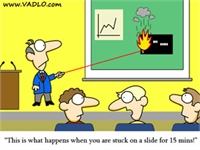
Using audio and visual silence to drive a point
Important Notice: Our web hosting provider recently started charging us for additional visits, which was unexpected. In response, we're seeking donations. Depending on the situation, we may explore different monetization options for our Community and Expert Contributors. It's crucial to provide more returns for their expertise and offer more Expert Validated Answers or AI Validated Answers. Learn more about our hosting issue here.

Using audio and visual silence to drive a point
You must be logged in to post a comment.
After a wonderful introduction, the speaker walks out to center stage. She stands there, microphone in hand, looking out at the crowd. For 45 seconds, she says nothing as she makes eye contact with several members of the audience, offering each one only a sheepish smile. Soon, several people giggle nervously. It seems the silence is louder than anything else in the room.
Finally, the speaker grins widely and says, “Boy, that was awkward,” allows a hearty laugh from her audience, and proceeds to talk about overcoming social anxiety by recognizing that we’re all in this thing together. The speaker immediately had her audience in the palm of her hand because she said…
…nothing.
Sometimes, the most powerful thing we say in a presentation comes from what we don’t say.
Pause for effect, laughs, and memory
Sure, the above is an extreme example, but it does illustrate the importance of a pause. As speakers, we are often so focused on what it is that we want to say, we forget just how important it is to allow a bit of silence now and then. Your audience needs to breathe every bit as much as you do – allow them the luxury! Speakers must find that delicate balance between pontificating and performing. The pause is a simple, yet very effective tool.
A short pause between points allows your listeners to regroup. You will find that slowing down, even stopping, will make a dramatic point. If someone has his head down taking notes, he might connect with your cadence – but get caught by your pause. A quick moment of silence says, “This is important – lean in for the goods!” If done well, you will actually find members of your audience leaning forward to listen more intently.
If you are adding humor to your speech – remember to leave room for your audience to laugh! If you talk over the top of (or “step on”) their laughter, you are taking away their permission to do so, and they might not laugh at all the next time you say something that should be funny.
When you are very passionate and energetic, your audience will be, too. You must give them a chance to catch up, catch on, and digest what you are saying. If your audience is exhausted and overwhelmed, your message will not get through. Mixing up your message with vocal variety, gestures, and a good, hearty pause at an important spot will not only allow your audience to follow along, it will keep them engaged.
The same is true for a visual presentation – give them a moment of non-visual stimulation to refocus on you, the speaker, like they’re supposed to!
PowerPoint pauses
As my other article stated (PowerPoint – are your slides pointing away from YOU?), your slides should enhance your presentation, not BE your presentation. If people are furiously taking notes off of what they see on the screen, they are not listening to you. If they are staring at some beautiful scenery, a convoluted bar graph, or pictures of kittens, they are not listening to you. If they are not listening to you, then why are you presenting?
Perhaps you have your slides showing the key terms of your main points. Show them a term, and then turn it off to talk about it. Don’t hide behind (or in front of) your slide. Make your audience focus on you. This method hits two of the three learning styles (visual and audio) – meaning better retention of your material.
You have two choices when deciding to incorporate visual silence: the blank slide and the black screen. A blank slide is easy – just add a slide full of…nothing…between the other slides. This is good if you have a memorized, rehearsed presentation and you are certain of where you will be expanding on an idea or doing some sort of audience involvement.
The second way is good both for a rehearsed presentation and for those that may have question sessions or exercises along the way: turn on a black screen whenever you need to. You can do this by pressing the “b” key on your computer. (“b” as in “blank” or “black”) Some remotes have a "mute" button that does the same thing. Easy peasy!
Take a deep breath
Allowing pauses into your presentations serves you on many levels. First, it allows your audience to better follow you. Second, it offers them the opportunity to take a rest between points. Third, it offers you an effective tool to show that what you just said – or what you are about to say – is very important. Last, it’s a nerve buster. Forgot your next point? Take a deep breath and regroup. Your audience will just assume that the next point is significant. And, really, everything you say in your presentations should be meaningful, right?